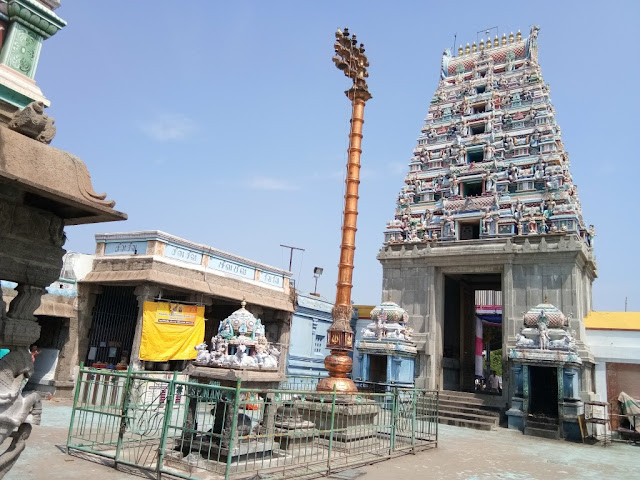Kurungaleeswarar
Temple, Koyambedu – The Temple
The temple is having seven tiered Rajagopuram. The
temple is facing north with a 16 pillar mandapam is in front of
Rajagopuram and four sides of each pillar has the reliefs of Shiva
Parvathi, Hanuman, Sarabeswarar, Raavanan, Shiva dances, etc. There is no other
Shiva temple facing north side. The pillars of the mandapams in the temple are
full of exquisite sculptures and carvings. Balipeedam, Nandhi and Dwajasthambam
are located immediately after the Rajagopuram.
Nandhi is located in the outer prakaram facing the
presiding deity. The Nandi has a rope through its nostrils with a leg bent very
prominently as if in a raising position. Presiding Deity is called as Kurungaleeswarar
/ Kusalavapureeswarar / Kusalaveswarar / Gnana Prakasar / Gnanapureeswarar.
Lord is housed in the sanctum facing north. Presiding Deity is in the form of
small Lingam of palm size.
There are Kabala Bhairava and Veerabhadra under the
tower. Vinayagar & Brahma on the east side, Dhakshinamoorthy on the back of
Sanctum (in place of Lingothbavar), Mahavishnu & Vishnu Durgai on the west
side of sanctum are the Koshta Deities located around the sanctum walls. Chandikeswarar
is found in his usual location near Durga. There are idols of Lord Nataraja and
63 Nayanmars can be found around the sanctum.
Mother is called as Dharmasamvardhini / Aram Valartha Nayagi.
She is housed in a separate shrine facing north. She is beautiful and is seen
in standing posture. The Goddess has her left foot forward as if coming down to
answer the prayers of her devotees which is noteworthy. Her shrine is located
on the right side of the Sanctum.
The Navagraha shrine (9 planets) in front of the Goddess
is on a stage designed as a lotus. Thiruvalam Sri Mouna Guruswamigal installed
this new Panchavarna Navagraha idol in the temple. Sun appears on a chariot
drawn by seven horses with his consorts Usha and Pradyusha. Charioteer Aruna is
holding the reins. This is a rare form. Days are calculated on the basis of the
journey time of Sun. It is said that worshipping Sun on special days as Ratha
Sapthami in the Thai (January-February) month is very beneficial. The floor
portion of the shrine is yellow, lower part is white, the Lotus part is red,
chariot black and the deities are in green – five colours. This is a different
temple design.
There is
a multi-pillared mandapam located between the two temples. The figure of Lord
Sarabeswara is found in one of the pillars. This sculpture has become very
popular in the recent years. Pooja is performed to Sarabeswara at the Rahu Kalam
time (4.30 – 6.00 p.m) on Sundays. Due to this, the Sunday Pradoshams sees
heavy crowd. There is also a perennial lamp near Sarabeswara.
There
are shrines of Kasi Viswanathar with his consort Visalakshi and Lord Murugan
with his consorts Valli & Deivanai, located adjacent to each other behind
the sanctum. Saint Arunagirinathar has sung in praise of this Muruga
calling him Kosainagar Vaazh Muruga. Vinayagar shrine is located in the
outer prakaram at the south west corner of the temple. The shrines of Jurakeswarar,
Shasta, Somaskandar, Gnana Saraswathi, Mahalakshmi and Nalvar are also found in
the outer prakaram of this temple.
Yaha
Salai and 4 Pillared Mandapam can be found in the outer prakaram of the Temple.
The temple also maintains a beautiful garden (Nandhavanam) along the outer
prakaram. The holy tree (Sthala Vriksham) of this temple is Jack tree. Theertham
associated with this Temple is Lava Kusa Theertham, believed to have been
created by the two sons of Sri Rama.
The
temple has 14 inscriptions, which date back to the period of Kulothunga Chozhan
III and the Vijayanagar kings. These inscriptions, besides explaining the gifts
made to the temple, show that the area formed part of Mangattu Nadu in
Kulothunga Chozha Valanadu in Puliyur Kottam of Jayankonda Chozha Mandalam.
They give the name of the place as Kosai Nagar, Koyattipuram and
Prayachithapuram and call the deity Kurungalaandar. Kulothunga Chozhan is said
to have ruled in the 12th Century and the temple here was reportedly
built during this period.


















